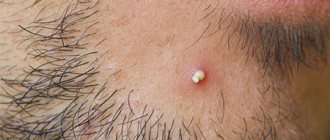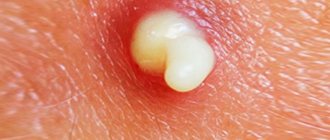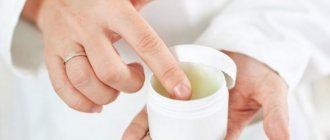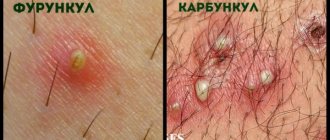A furuncle (known to many as a boil) is a purulent acute inflammation of the hair follicle on the skin, which is provoked by Staphylococcus aureus. Most people take this inflammatory process very lightly, although Staphylococcus aureus itself is very dangerous for humans. Many people make a big mistake, trying to get rid of the boil that appears on their own, which in the future can provoke a number of undesirable consequences.
Inpatient therapy
According to ICD-10, a boil has a special code LO2. Inflammation can form in an intimate place, on the legs and head. If the abscess is not opened, the infection will spread throughout the body. The process can cause various pathologies of the lungs, brain and liver. To prevent complications, it is recommended to eliminate the disease in a timely manner. Symptoms that require the help of a surgeon:
- high body temperature;
- weakness;
- edema;
- pain;
- large abscess.
The clinical picture indicates the onset of internal inflammation. The abscess abscesses. It is recommended to make an appointment with a surgeon. The doctor examines the patient and collects anamnesis. If the boil cannot open on its own, treatment with Ichthyol ointment or Vishnevsky liniment is indicated. Medications have anti-inflammatory and antiseptic effects.
Before surgery, the patient must follow the rules of hygiene and refuse water procedures. In a hospital setting, boil removal is carried out using ultrasound and laser. The procedure is performed under local anesthesia. The area where the boil is located is treated with an antiseptic.
Excision of the boil begins with making an incision with a scalpel. Then the purulent core is removed. It is recommended to treat the wound with hydrogen peroxide. At the next stage, a special tube is installed to drain the pus. Since the procedure is performed under anesthesia, the patient does not experience pain or discomfort.
Subsequent therapy is prescribed by the doctor to eliminate the remaining compaction. It includes the use of wound-healing ointments and antibiotics. If the operation is performed correctly, relapse is excluded.
Home treatment
Opening the boil yourself is not recommended. The likelihood of secondary infection or partial removal of pus from the wound increases. An unremoved rod provokes serious complications:
- sepsis;
- secondary infection due to non-compliance with sanitary and hygienic standards;
- chronic furunculosis;
- the appearance of a scar;
- phlegmon.
If the boil does not mature for a long time, it is treated with an antiseptic. You can apply warm compresses using a heating pad. The ripening process lasts up to seven days. Before opening the boil, it is also treated with an antiseptic. Using sharp scissors or a needle, the head is pierced.
Pus is removed with sterile wipes. The rod should come out along with blood and pus. If it is inside the wound, there is a chance of recurrence. To prevent infection and infection, it is recommended to use antibacterial ointment.
The sterile dressing is changed daily. If the wound does not fester, a wound healing ointment is used.
How long the treatment will last depends on the success of the manipulation. The boil can break through without intervention. If it is ripe, it is recommended to prepare a sterile bandage and antibacterial wipes. You cannot squeeze out a boil on a child yourself.
Indications for surgical opening of a boil
Removal of the boil occurs at the final stage of its development. If an abscess has formed on the face, you should consult a doctor immediately to prevent the occurrence of severe complications - such as sepsis, thrombosis of the sigmoid sinus.
Opening a boil is carried out if the following indications are present:
- localization of the boil occurs in the area of the upper lip, wings of the nose, near the lymph nodes;
- several abscesses formed at the same time;
- an abscess has formed under the skin;
- the location of the boils is in the deep layers of the skin;
- the size of the boil exceeds one centimeter;
- the presence of diabetes mellitus in the patient;
- elderly or childish age of the patient.
Postoperative actions
To ensure that the wound can heal quickly, proper care after opening is indicated. If the manipulation is performed in a hospital, the surgeon washes the wound with an antiseptic and applies a bandage. Subsequent treatment is prescribed by the doctor. For frequent relapses, antibiotic therapy with vitamins is indicated.
The wound should not be left open to avoid an infectious or inflammatory process. The bandage is changed up to three times a day. Using a sterile napkin, the ichor is processed and the ointment is removed. You can wash the wound with Chlorhexidine and apply antibacterial ointment on top.
If you cut out the boil incorrectly, a seal will remain. In this case, the help of a doctor is required. It will be necessary to open the wound to remove the root from the follicle. The patient may experience pain during the procedure. After the procedure, antibacterial and wound healing agents are applied to the wound:
- Tetracycline ointment;
- Solcoseryl;
- Hydrocortisone ointment.
Duration of rehabilitation
It takes about seven days for the wound to heal after opening the boil. The rehabilitation process depends on the size of the abscess, the presence of concomitant diseases, and the clinical picture. The mild course of the disease does not provoke complications. If you regularly apply special treatments, the healing process will significantly speed up.
In the absence of postoperative treatment, a relapse develops and multiple inflammation is observed. Treatment of the boil after opening is carried out within five days. When using Levomekol, the use of the antibiotic is limited to 5 days. Addiction to the components of the drug is excluded. If necessary, Rescuer cream is included in the regimen.
Signs of successful wound healing:
- the problem area to the touch has the same temperature as the rest of the skin;
- presence of smooth dermis;
- lack of seals;
- normal skin color;
- no pain when touched.
Improper surgical treatment can lead to an increase in body temperature during the rehabilitation period. More often the indicator is 37 °C. Heat indicates inflammation. In this case, it is recommended to inform your doctor. The specialist develops a drug treatment regimen. If there are indications, the wound is re-opened and cleaned. After surgery, attention is paid to your overall health. Frequent dressing is indicated.
Stages of boil development
At the beginning of the progression of the inflammatory process, the tumor-like formation is very similar to a regular pimple and, at first glance, is indistinguishable from it. It is a small bump surrounded by skin that has taken on a redder hue. If you put a little pressure on the boil, you will notice that it feels harder to the touch than a regular pimple. The main difference is the presence of pain, which is felt more clearly.
The second stage is characterized by a significant increase in the size of the boil. The formation can be easily felt and noticed on the skin; an increasing amount of pus accumulates inside it. The pain intensifies. The boil causes discomfort not only when pressing on it, but also in a calm state.
The neoplasm reaches up to three centimeters in diameter, in its center the formation of a furuncle rod occurs, it takes on a cone-shaped shape. The pain becomes very strong, sometimes unbearable, symptoms of intoxication are added - nausea, malaise, constant drowsiness and weakness, body temperature can rise to 39 degrees. As a result of mechanical impact, the boil may open.
Advice from surgeons
If an abscess breaks, it is recommended to monitor the drainage of pus. And also attention should be paid to the condition when the pus has come out, but the rod remains. In this case, the abscess will recur after some time. In this case, the area of the abscess can periodically be covered by the epidermis, and then break through again.
A non-healing boil can only be treated in a hospital with simple surgery. Tasks of a surgeon or dermatologist:
- providing recommendations for wound treatment after removal of pus;
- prescription of drugs;
- providing recommendations for changing dressings.
The duration of the rehabilitation period depends on proper wound care, the degree of skin damage, and immune strength. If the boil does not go away for more than a month, it is recommended to undergo follow-up treatment under the supervision of a doctor.
Appearance of a scar
After the wound heals, a dark spot appears from the boil. In some cases, the consequences of an abscess look like small pits that do not differ in color from healthy skin. To eliminate the red spot that appeared from a recent boil, medications are used: ointments and creams, formulations with collagen and vitamins. Such postoperative therapy promotes rapid regeneration.
The appearance of a black spot indicates an almost formed scar, which is formed by connective tissue. There may be a small depression underneath. Such a mark can only be removed with the help of an experienced dermatologist or cosmetologist. The following methods are used for this:
- laser removal;
- chemical peeling (a procedure that improves and smoothes the skin texture);
- mesotherapy (injections of vitamins and hormones to rejuvenate and tighten the skin).
Ways to speed up wound healing
To ensure that there is no scar after boil removal surgery, it is recommended to properly treat the wound. Modern surgeons, dermatologists and cosmetologists advise dealing with the problem using certain medications. The drug Contractubex is available in the form of cream and ointment. Other effective scar prevention products:
- Bepanten. The cream accelerates skin regeneration and helps to heal the wound faster after removing an abscess.
- Solcoseryl. It is an analogue of Bepanten. Their difference lies in the price.
- Levomekol. An ointment that draws out purulent contents from a wound. Levomekol is used if there is pus left in the wound or if the ichor has come out of an unhealed hole.
- Mesotherapy cocktails. Due to superficial administration, they completely smooth out the scar on any area of the face.
To eliminate the scar as quickly as possible after removing a boil, laser skin resurfacing is used. The procedure is carried out in a beauty salon. If complications arise during therapy, it is recommended to consult with your doctor.
Prognosis and prevention
The prognosis for a simple boil is favorable. The wound heals without leaving a mark, or with the formation of a pinpoint scar. The complicated course of the disease in the form of progressive thrombophlebitis of the head veins, meningitis, sepsis threatens with serious consequences, including death.
Prevention consists of following the rules of personal hygiene and strengthening the immune system. The development of complications can be avoided by timely contacting our clinic, where you will be provided with qualified assistance in full.











